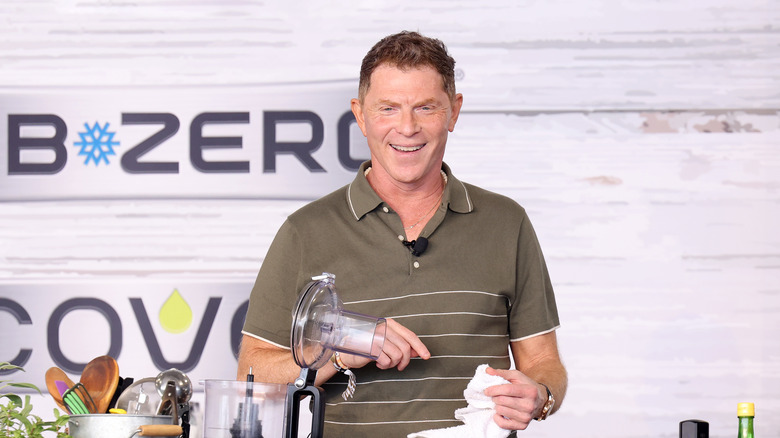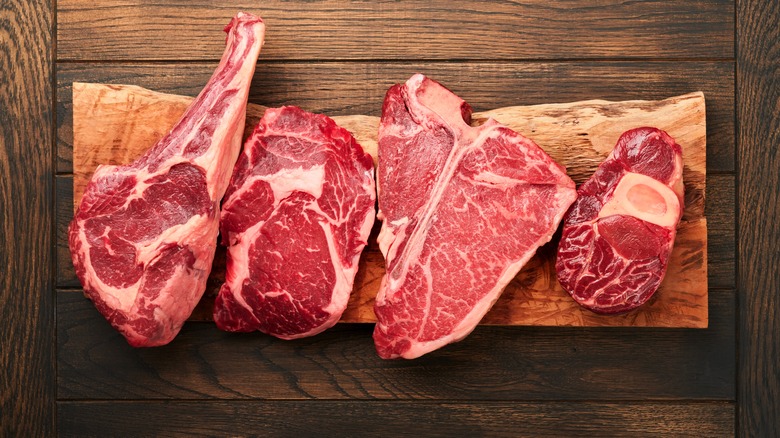Why Bobby Flay Never Buys Prepackaged Steaks
Bobby Flay is an acknowledged master of all things grilling, a talent that the acclaimed chef has showcased on Food Network shows like "Boy Meets Grill" and "Hot Off the Grill with Bobby Flay."
Flay has never been shy about sharing his knowledge, regularly offering advice on a variety of outdoor cooking topics. His latest recommendation, for example, is to avoid buying prepackaged steaks. He believes the plastic wrapping traps too much moisture, which can be detrimental to the meat's quality. Excess moisture can be a problem when cooking, particularly when trying to achieve the Maillard reaction for a perfectly seared steak. This reaction is responsible for browning and creating grill marks, and both taste and appearance can be affected if the meat is too wet. Moreover, prepackaged offerings often aren't the best quality cuts.
Instead of opting for plastic-wrapped meat, Flay advocates for sourcing cuts from a butcher. No, this doesn't necessarily mean visiting an old-fashioned butcher shop; the counter at your local supermarket will do just fine. There, you are likely to find restaurant-quality steaks and other ingredients, and you'll get more information about how the beef was raised. The finished product will likely taste noticeably better, too.
Shopping for steaks at the butcher shop
Butcher counters or old-school shops typically offer a much wider selection than what is displayed in a supermarket. These steaks are likely to be fresher and more sustainably sourced, and unlike prepackaged beef, most local meat professionals will slice your order while you watch. This means you can ask your butcher for advice, or specify a preferred thickness level. Because the prices are comparable to those in supermarket aisles, you may not even have to pay more for the upgrade in quality and personal service.
Visiting your local butcher can also introduce you to different aging techniques. Most prepackaged supermarket cuts, for instance, are wet-aged, meaning they are sealed in plastic, allowing them to retain moisture and acquire a strong flavor due to contact with natural juices. Generally, dry-aged beef is only offered by butchers or specialty shops. This meat is exposed to oxygen, which gives it a patina of mold that is trimmed off before it's sold to you. While it may sound unappetizing, this is similar to the growth on the finest blue cheeses. The often lengthy dry-aging process is notable for producing incredibly tender and flavorful steaks.
More steak and grilling tips from Bobby Flay
Bobby Flay has shared tips on every aspect of the grilling process, from what to look for when shopping, to how long to let the meat rest after cooking. According to the chef, the best steaks to buy are those with the highest grades — USDA Prime, for example — but preference should also be given to cuts that exhibit the best marbling. More intramuscular fat generally means more flavor.
Letting your steak rest before and after grilling is also important. Before grilling, about 20 minutes is needed to allow refrigerated or frozen meat to reach room temperature; otherwise, it won't cook evenly. After grilling, resting allows the juices to settle so they don't run out with the first cut. A minimum of five minutes of rest time is recommended, with the beef covered loosely in foil.
Regarding the grill itself, Flay notes his preference for charcoal over gas as a heating source, not only for a more traditional grilling experience, but also for the better flavor it imparts to the food.



